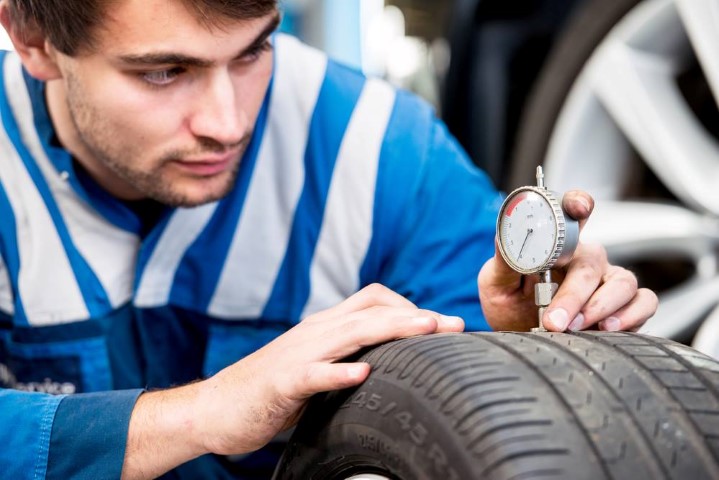Shopping a new air compressor for the garage seems like a needlessly wasted expense. So how much money will an air compressor save you? Or is it just a liability?
Every time you pull up to the tire shop, you are reminded of how expensive it is to get a new set of treads. While it’s easier to baby the racing treads and protect our “babies”, our daily driver absorbs the constant abuse.
For those of us who drive SUVs and Trucks, the expense of this daily wear and tear can really hit that pocketbook.
The right PSI effects fuel mileage. It also plays a major role in your tire’s lifespan.
Here’s a few quick tips on how to save money by paying a few minutes attention to this often-neglected maintenance schedule. Do it right, and you’ll make it easier to pay for Christmas! (or buy yourself that new set of wheels you’ve been eyeing.)
Use The Proper PSI
On the inside of your driver side car door, there should be a chart with the correct PSI ratings for your car. Most of us get in and out of the car and never thing to look at those stickers. But on all newer model cars, that sticker is there.
This sticker is your best guide to getting the longest life from your tires. With a cheap gauge you can easily check the tires current pressure level, and then add air as necessary. If your car is new enough, it may have a setting on the dash that lets you see the current tire pressures. That makes checking it quick and easy.
Sure, it takes a few minutes to check the pressure and top off the tires, but you’ll be thankful that you invested that time when you get to go a few months longer without having to replace your tires.
How Often Should You Air Your Tires?

You should check your tires monthly. Most of us have a TPMS sensor that will notify us if the tires get too low, but our goal is to check them frequently enough to get the dollar savings that come from properly maintained tires.
The big factor for proper inflation relies greatly on the weather. A temperature swing of 10 degrees can effect the pressure by 1 or 2 PSI.
Ever gone out to your car on a cold morning and discovered that you TPMS sensor was on? That likely means that your tire dropped in pressure by 25% below the manufacturer’s recommended inflation, and triggered the light. It also is a sign that your tires were likely already underinflated and running in a sub-optimal condition prior to the temperature drop.
Checking your tires monthly lets you catch the bulk of these problems and should give you the Dollar savings you are looking for.
This biggest challenge with maintaining the proper tire pressure is finding the time to air up your tires. If you are lucky, there is a gas station near you that offers free air. (Second best is a service station with air that you have to pay for). One of the easiest hacks is to get a cordless air compressor or 12 volt air compressor that you can keep in your car. Here’s a list of these compressors: https://www.tooltally.com/best-12v-air-compressors/
How Much Money Does Properly Aired Tires Save You?
The EPA estimates that you can save 3% in fuel economy by having your tires properly aired. Now this may not seem like much, but over a year’s time, if driving 12,000 miles per year at 20 miles per gallon, that could save $50 to $60.
If your air compressor only cost $20, then you could be doubling the money you invested in an air compressor. Those savings go up even more if you are able to use the compressor at a nearby gas station.
When properly inflated, your tires distribute the car’s weight across the tread pattern in a proper, fully optimized manner. This keeps the treads from being worn down unevenly, prevents punctures and overall lengthens the life of your tire. Underinflated tires experience faster wear on the sides and force you to buy replacements even before the entire tire has been used to its full extent.
Driving with a tire that is underinflated by 6 PSI can shorten the lifespan by 25%. In the worst case scenario, it can lead to tile failure.
Conversely, when you calculate that properly inflated tires can last 25% longer, that’s an estimated $75 back into your pocket on a $300 tire change. Most tires will last about 36,000 to 45,000 miles, so that should be an extra $25 dollars per year back into your pocket.
Savings Through Safety
The biggest savings from properly inflated tires come through the increased safety.
Tires are the only connection between your vehicle and the road, and keeping them in top shape is required to get the maximum performance from your steering and from your brakes.
While the $50-$75 savings in gas and tire replacement is a nice benefit, the real value comes from the accidents you never have.
Next time you are vacuuming out your car take time to check the air pressure in your tires. And then go treat yourself to that accessory you’ve been saving up for. You’ve earned it with the savings from your properly inflated tires.










